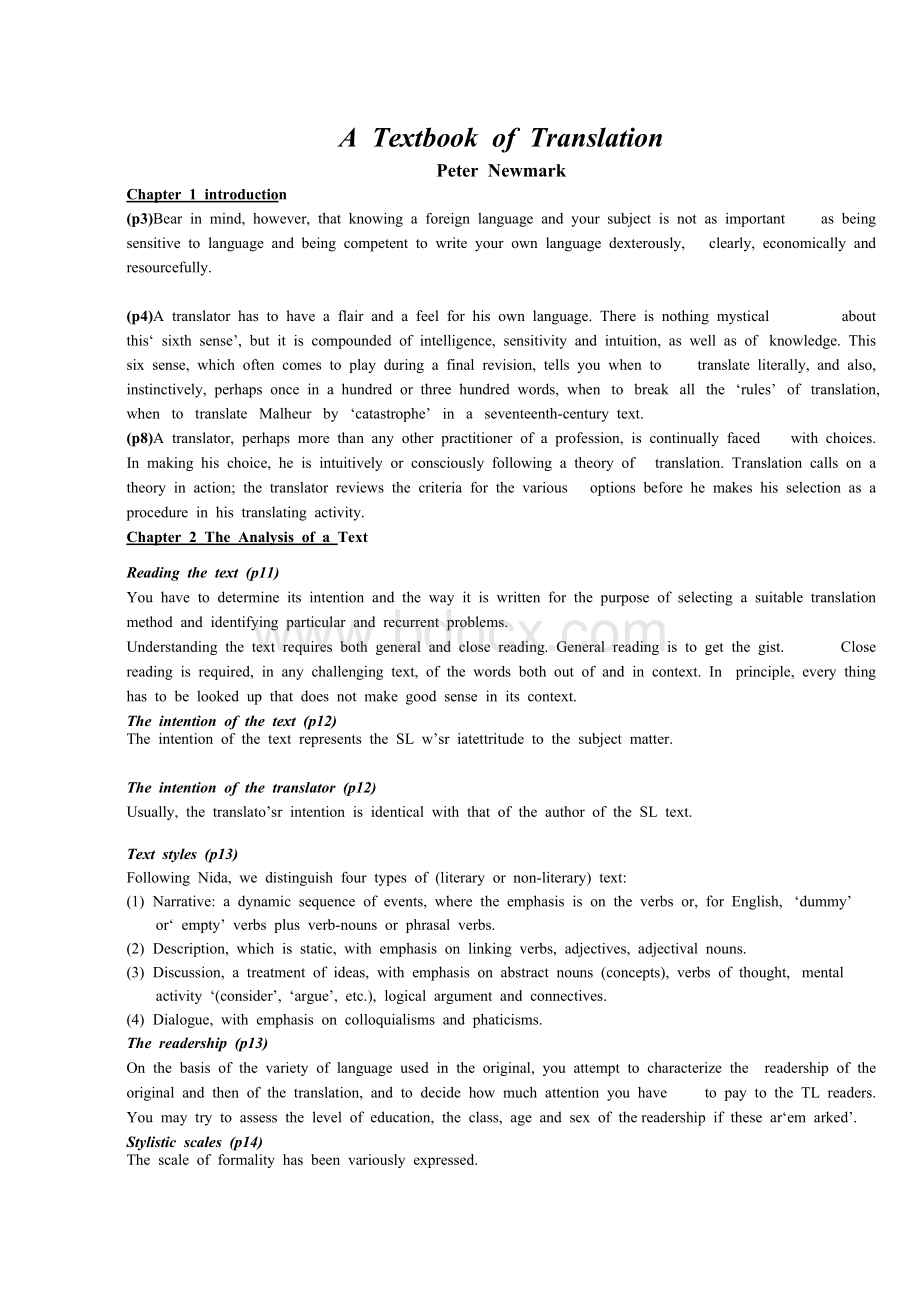【完整版】(Newmark)ATextbookofTranslation(周骄俪).docx
《【完整版】(Newmark)ATextbookofTranslation(周骄俪).docx》由会员分享,可在线阅读,更多相关《【完整版】(Newmark)ATextbookofTranslation(周骄俪).docx(36页珍藏版)》请在冰豆网上搜索。

A Textbook of Translation
Peter Newmark
Chapter 1 introduction
(p3)Bear in mind, however, that knowing a foreign language and your subject is not as important as being sensitive to language and being competent to write your own language dexterously, clearly, economically and resourcefully.
(p4)A translator has to have a flair and a feel for his own language. There is nothing mystical about this‘ sixth sense’, but it is compounded of intelligence, sensitivity and intuition, as well as of knowledge. This six sense, which often comes to play during a final revision, tells you when to translate literally, and also, instinctively, perhaps once in a hundred or three hundred words, when to break all the ‘rules’ of translation, when to translate Malheur by ‘catastrophe’ in a seventeenth-century text.
(p8)A translator, perhaps more than any other practitioner of a profession, is continually faced with choices. In making his choice, he is intuitively or consciously following a theory of translation. Translation calls on a theory in action; the translator reviews the criteria for the various options before he makes his selection as a procedure in his translating activity.
Chapter 2 The Analysis of a Text
Reading the text (p11)
You have to determine its intention and the way it is written for the purpose of selecting a suitabletranslation method and identifying particular and recurrent problems.
Understanding the text requires both general and close reading. General reading is to get the gist. Close reading is required, in any challenging text, of the words both out of and in context. In principle, every thing has to be looked up that does not make good sense in its context.
The intention of the text (p12)
The intention of the text represents the SL w’sr iatettritude to the subject matter.
The intention of the translator (p12)
Usually, the translato’sr intention is identical with that of the author of the SL text.
Text styles (p13)
Following Nida, we distinguish four types of (literary or non-literary) text:
(1)Narrative:
a dynamic sequence of events, where the emphasis is on the verbs or, for English, ‘dummy’ or‘ empty’ verbs plus verb-nouns or phrasal verbs.
(2)Description, which is static, with emphasis on linking verbs, adjectives, adjectival nouns.
(3)Discussion, a treatment of ideas, with emphasis on abstract nouns (concepts), verbs of thought, mental activity ‘(consider’, ‘argue’, etc.), logical argument and connectives.
(4)Dialogue, with emphasis on colloquialisms and phaticisms.
The readership (p13)
On the basis of the variety of language used in the original, you attempt to characterize the readership of the original and then of the translation, and to decide how much attention you have to pay to the TL readers. You may try to assess the level of education, the class, age and sex of thereadership if these ar‘em arked’.
Stylistic scales (p14)
The scale of formality has been variously expressed.
Note that there is some correlation between formality and emotional tone, in that an official style is likely to be factual, whilst colloquialisms and slang tend to be emotive.
Attitude (p15)
In passage making evaluations and recommendations, you have to assess the standards of the writer. If he writes ‘good’, ‘fair’, ‘average’, ‘competent’, ‘adequate’, ‘satisfactory’, ‘middling’, ‘poor’, ‘excellent’, are his standards-- relative to the con—texatbsolute, generally accepted in his culture, or arbitrary?
Setting (p15)
You have to decide on the likely setting:
where would the text be published in the TL?
What is the TL equivalent of the SL periodical, newspaper, textbook, journal, etc?
or who is the client you are translating for and what are his requiremen ts?
The three typical reader types are perhaps the expert, the educated layman, and the uninformed.
The quality of the writing (p16)
The quality of the writing has to be judged in relation to the author’s intention and/or the requirements of the subject-matter.
Chapter 3 The Process of Translating
The relation of translating to translation theory
(p19)The purpose of this theory of translating is to be of service to the translator. It is designed to be a continuous link between translation theory and practice; it derives from a translation theory framework which proposes that when the main purpose of the text is to convey information and convince the reader, a method of translation must‘ nbaetu ral’. ‘Naturalness’ is both grammatical and lexical, and is a touchstone at every level of a text, from paragraph to word,, from title to punctuation. The level of naturalness binds translation theory to translating theory, and translating theory to practice.
(p20)The theory of translating is based, via the level of naturalness, on a theory of translation. Therefore one arrives at the scheme shown in Figu re 2:
The Approach (p21